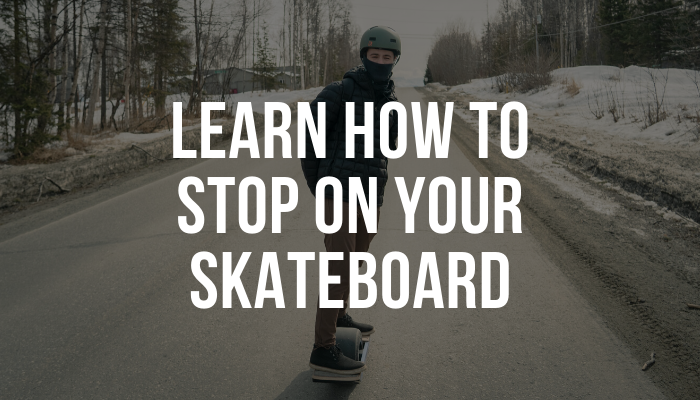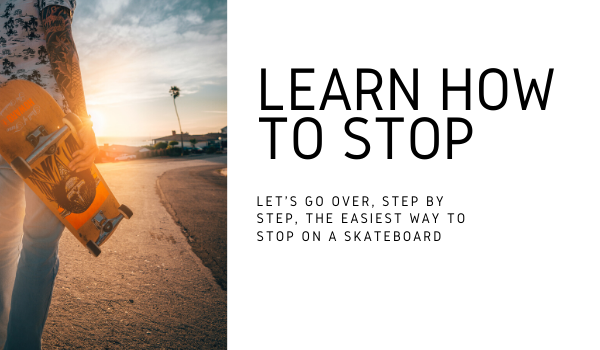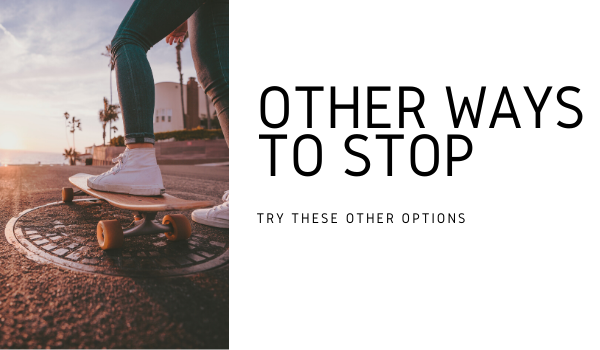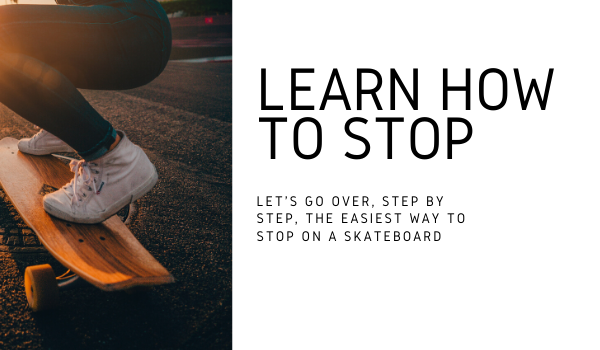
As you probably know by now, staying safe on your skateboard is the result of a few things. Mainly, it’s about using proper safety gear and practicing your skateboarding skills. What’s the best way to keep yourself safe while riding? Learn how to stop on your skateboard.
Learning how to stop is a skill you learn very early on and it is the one that you will use every time you ride. It helps you avoid others, avoid jumps or drops that you might not be ready for, and brings another element of fun to skateboarding!
Step-by-step Instructions: How to Stop

Here is the quickest, safest list of step-by-step instructions for stopping on your skateboard. We are using the drag method, sometimes called the foot brake, best used on flat surfaces where you are not traveling at high speed.
- Start by turning your front foot so that it’s pointing toward the front of your board, like you’re pushing with your back foot.
- Drop your back foot off the board, near the rear set of wheels, preparing to put your foot flat against the ground.
- Start by putting very light pressure against the ground with your foot. (As always, wear shoes when skateboarding or longboarding!)
- As you slow down and get balanced, put more pressure on your back foot.
The goal is to slow down to a complete stop with both your feet flat on the ground. By putting pressure on your back foot and slowly stopping, you’ll stay extra safe.
Additional Tips for Easy Stopping

You don’t need to be pointing it directly at the front when you point your foot toward the front of the board. You just don’t want it pointing sideways. That will cause you to fall. You always want to be in control of your body when your’re skateboarding. Body position and balance are important!
Wear shoes that are in good shape. It’s not realistic to always have a perfect set of sneakers on but they will need to have decent soles.
It will sound it but it may take a few weeks of practice to get it right. That’s ok! You’ll be learning so many new things on your board during the first few weeks and your stopping skills will come along just fine.
Stopping Tips for Complete Beginners

We want to give you permission right now to jump off your skateboard to stop. It’s not pretty. It is effective. Most beginner skateboarders do this by default. It’s their first instinct when they get scared. While you are responsible for who and what our skateboard hits after you jump off of it, jumping off your board is not a bad idea.
Even pro skaters jump off to stop sometimes. Watch any compilation or session and you’ve probably seen the same thing. If it’s easier to jump off as you learn how to properly stop, go for it. The key is to keep riding and keep practicing.
Using your tail is also an option. This is a simple method where you put your back foot on the tail, behind the trucks and wheels, and then shift your weight onto that back foot as you let up on your front foot. The result is that the tail of your board hits the ground and drags you to rest.
Lots of skateboarders find this an easy way to stop. It does require a different type of balance but it’s likely that this feels comfortable to beginner and experienced riders alike. This is a very natural movement for standing on a skateboard for the first time. Additionally, you may have tried popping up your board and catching before you learned how to properly push. We definitely did!
The benefit is that you don’t wear down your shoes by dragging your feet, you can turn and stop at the stop time, and you are in full control of your board. You’ll often people call this way to stop a heel brake.
The key is finding the way that you feel comfortable stopping. Lots of accidents happen because we get into an uncomfortable position on our boards and let that stress us out. If you can learn a few different techniques to stop then you’ll be more comfortable on your board, will stop ore effectively, and you’ll ultimately get fewer injuries while you ride.
Downhill Skateboarding: How to Stop With a Powerslide

Downhill is quite extreme. You will use the basic riding skills you learned as a beginner and build on those skills. In general, we recommend only professionals choose downhill as a way to ride their board. Why? Safety statistics for skateboarders indicate that, while the sport is very safe compared to others, the major injuries largely coming from riding on the road. Downhill skating is exclusively on roads and is considered a little more dangerous. You are traveling at a faster speed on steeper hills and falling becomes more dangerous too. Check your local laws and regulations about when and where it’s lawful to ride your skateboard.
Should you choose to ride some small hills, we want you to be safe and know how to stop. In this guide about stopping, we are going to assume that the hills you are going down are relatively small. You will be able to stop easier on large hills if you master the basics of stopping on small hills.
Riding downhill will feel strange at first. Admittedly, it’s not an easy style of skateboarding to learn. Much like the rest of our skateboard safety advice, please work your way up to going down hills, wear safety gear, and take extra safety precautions. You can take some extra precautions, though.
Powersliding is an advanced technique that lets you put the pressure of stopping fully on your wheels. This has the opposite effect of using your shoes or your tail and wearing those down. You essentially turn your board quickly so that you are facing forward while your feet are parallel underneath you on the board. Your weight being on your front foot allows you to swing your back foot around easier. It’s very similar to stopping on a snowboard.
Professional downhill skateboarders often use special tools to stop on a downhill like sliding gloves. Sliding gloves have a special disk in the palms so that skaters can put their palm on the ground while sliding. This is not the primary way to break but it does add friction to a skateboarder as they turn. This may help them stop with a powerslide.
How To Stop Videos: How to Stop on Your Skateboard
It always helps to see someone else do it, especially someone giving instructions as they do it. Check out a few videos from experts on how they recommend you stop and see what works for you. Try practicing in a controlled environment where you can avoid cars and other people.
There are some fantastic tips in this short video. The skateboarder covers three main ways: dragging your back foot, using the tail, and performing an emergency stop. We know all about those three from our guide on how to stop.
A YouTube antique, uploaded in 2008, is another good and short example of two stopping techniques that we discussed: the tail and foot drag.
If you only have one minute and want to get talked through the process, this video will do that well. We’re amazed at the quality of the video! We are also appreciate the clarity of the video.
Stopping & General Skateboard Safety
If you’re able to safely stop with the foot brake and the heel brake on a consistent basis, you’re on the right track to staying injury-free while riding your board. Nothing is guaranteed, but skills play a major role in staying safe on your skateboard. Practice pushing, carving, and braking on flat surfaces without any obstacles until you feel comfortable.
The other ways you can stay safe are by wearing proper skateboard safety gear and staying in shape. If you can master all of these then you’ll spend more time on your board and less time washing off your scrapes and bruises.